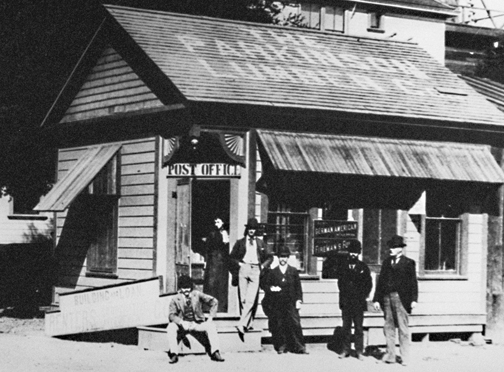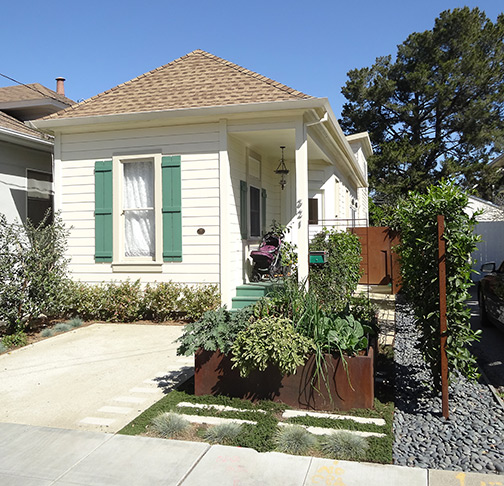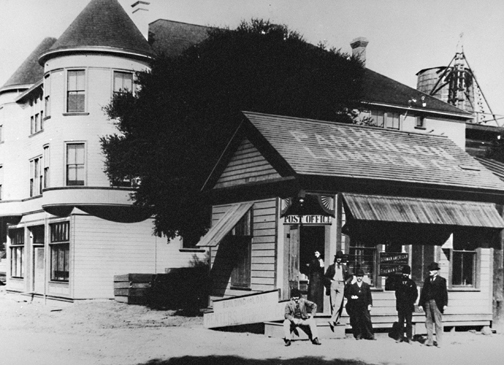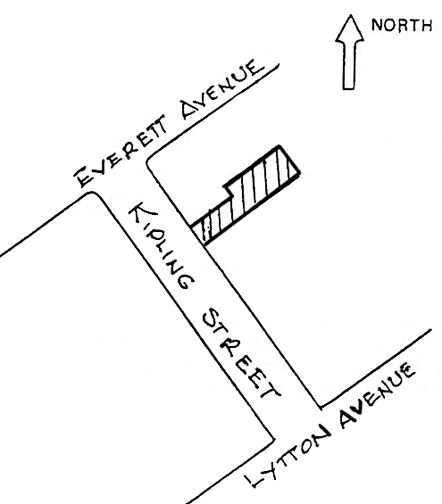 Palo Alto Stanford Heritage
Palo Alto Stanford Heritage
 |
 |
| Historic photo * | Photo taken March 5, 2015 by Lucy Spaziano |
The following is from the Historic Buildings Inventory as revised in 1985:
The importance of the building is historical rather than architectural. Originally, it was a simple rectangular box with front and side doors, divided into two interior rooms. Ornamentation consisted of notched shingles in the front gable pediment, and, over the front door, a turned pendant flanked by fan brackets. After being moved to its present site, the original wide ship-lap sheathing was shingled, the side door closed over, and the building was enlarged by a front porch and front room, a rear room, and a small bathroom and back porch.
Architecturally, this structure is inconsequential. its significance is as the first Palo Alto Post Office and the original Parkinson Company office and store. It was built in 1891-2 for John F. Parkinson, who had just come to the town and who was the town's first postmaster. He opened the post office in may, 1892, in the building. After has office was moved in 1894, he sold the building to John Beltramo of Menlo Park for $100.
Some time later—probably 1896—Beltramo moved the building to its present site, and it was probably then that it was enlarged. Beltramo and other owners between 1903 and 1906, rented it to, among others, a Mr. and Mrs. Schultze, the F. Linds, the E. D. Carothers, the Schweitzer family, and the Joseph Hara family.
From 1907-1912 it was owned and occupied by Theodore M. and Minnie Parrent, and from 1912 to 1924, by Charles M. and Rosa Stiles. Stiles, a plumber, added a bathroom, back porch, and basement.
Following the Stiles family was Miss Grace Hartley, a teacher, and her mother (1924-1925). It then was owned and occupied until 1961 by Miss Georgiana Montgomery, a saleswoman for the Frazer Company clothing store. After her death it soon passed to Marie Elizabeth Laufers.
* Note: The original structure can be identified by the angled entry at the rear of the modern porch and added front room.
 |
 |
| Original photo from Guy Miller Archives | Location map |
The following is from the Centennial Buildings Tour, prepared by The City of Palo Alto Historic Resources Board for the Centennial Building Celebration, April 16, 1994. The houses included on the tour were all identified as at least 100 years old:
Originally the Parkinson Company office and store which included Palo Alto's first post office, this building is important more for its history than its architecture. It was built by Palo Alto's first postmaster, John F. Parkinson, as a simple two-room box, but after being sold for $100 in 1894 to John Beltramo of Menlo Park, it was moved and enlarged with a front porch and front room, rear room, and small bathroom and back porch.
This house was built in 1891– 92 and is a Category 4 on the Historic Inventory. This house was built in and is a Category 4 on the Historic Buildings Inventory. The builder was John F. Parkinson. The property measures 25 by 112.5 feet.
Sources: The principal sources collected and summarized by the city historian, Guy C. Miller, are in the Post Office file of the Palo Alto Historical Association. Added to them is a detailed historical and descriptive analysis of James H. Stone, which includes among its sources relevant citations from Santa Clara County deeds and land records and notes from the interview with long-time neighbor, Mrs. Frank Smith, 320 Kipling Street. See also the Palo Alto Historical Association photography collection. The diagrams in the Sanborn Co. Fire Insurance Map of Palo Alto, May, 1908 (corrections added 1915 and 1919), show that the major alterations had been made by 1908.
E-mail us at either webmaster@pastheritage.org or president@pastheritage.org.
![]() Palo Alto Stanford Heritage—Dedicated to the preservation of Palo Alto's historic buildings.
Palo Alto Stanford Heritage—Dedicated to the preservation of Palo Alto's historic buildings.
Copyright © 2016 Palo Alto Stanford Heritage. All rights reserved.